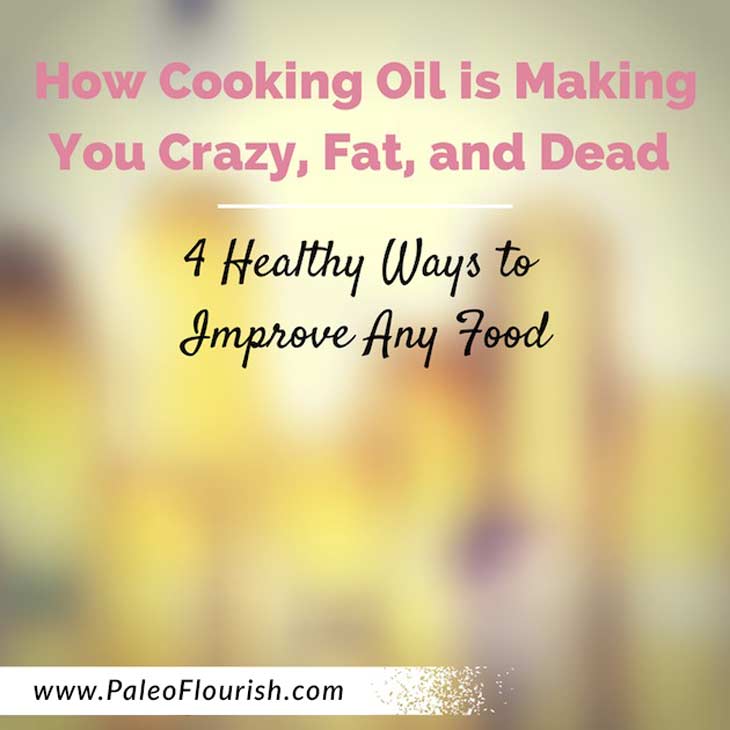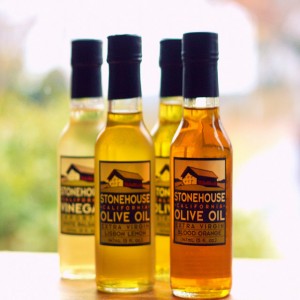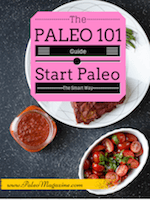How Cooking Oil is Making You Crazy, Fat, and Dead – 4 Healthy Ways to Improve Any Food

There is a way to potentially prevent 99.9% of bipolar disorders in the world.
This same method could also potentially prevent more than 25% of all cardiovascular deaths.
Those estimates are probably high, and yet here’s what is most striking about this potential solution:
1. It’s easy.
2. Almost nobody thinks that any potential harm would result.
So pardon me if I’m a bit flabbergasted at why this isn’t getting just a little bit more attention.
Excess Omega-6 Fats are a Problem
Just 100 years ago, Omega-6 fats were about 3% of total calories in the United States. Today, they’re almost 10%.
Here’s why that’s a problem, in the simplest terms possible:
Omega-6 and Omega-3 fats are turned into eicosanoids in your body. Eicosanoids act a lot like messengers in your body, telling your body to do things such as increase inflammation or begin an immune response.
In particular, one type of eicosanoid is called an endocannabinoid. Endocannabinoids are partially responsible for controlling your mood, your appetite, and even your memory.
In other words, the eicosanoids and endocannabinoids that are made from Omega-6 and Omega-3 fats are pretty important.
Unfortunately, when you get a lot more Omega-6 fats than Omega-3 fats, bad things happen.
When most of your eicosanoids and endocannabinoids are made from Omega-6 fats, you get hungry, moody, and eventually sick and dead, mostly because Omega-6 fats are much more inflammatory in your body and promote everything from cardiovascular disease to cancer to depression.
If you want to know more, read this short article from Dr. William Lands.
What the Heck Can You Do to Prevent This?
On the one hand, you could eat a LOT more fish to get more Omega-3 fats to balance out the Omega-6 fats.
But there’s an easier and better way…
Stop Eating Seed and Vegetable Oils!
Here’s a quick video, where I talk about this:
Remember how the percentage of calories attributable to Omega-6 fats has gone from 3% to almost 10%? That’s almost solely attributable to the oils that Americans (and many, many other folks around the world) cook in.
And this is an easy problem to fix.
How to Make ANY Food Healthier and Yummier
The oils you cook with might just be the least-healthy part of your diet, particularly since you use oils for cooking most of your foods.
Here are 4 ways to quickly and dramatically improve the overall quality of your diet and food:
1. Choose a Cooking Oil Low in Omega-6 Fats
(If you haven’t already, go read my recent article about the different types of fats.)
The healthiest cooking oils are high in saturated fats and low in Omega-6 fats.
In addition to all of the problems that Omega-6 eicosanoids and endocannabinoids cause, Omega-6 fats are also highly unstable. This means that the fats in those oils go rancid during (and often before) cooking. In fact, many oils are probably rancid by the time you buy them from your grocery store.
Your body can’t properly use rancid fats, which are more likely to cause chronic inflammation inside your body. Chronic inflammation, of course, increases the risk for various types of disease and generally keeps your body from functioning optimally.
This is the most important consideration – by far – when you’re deciding what kind of oil to cook with.
As an aside, oils high in monounsaturated fats are not as problematic as oils high in Omega-6 fats, since monounsaturated fats are more stable. Still, oils high in saturated fats are the best. (I’ve got a big list of oils below!)
2. Use an Oil with a High Smoke Point
 The “smoke point” of an oil is – unsurprisingly – the point at which an oil begins to smoke, but it’s also the point at which the fats in the oil begin to break down and the oil starts losing much of its flavor.
The “smoke point” of an oil is – unsurprisingly – the point at which an oil begins to smoke, but it’s also the point at which the fats in the oil begin to break down and the oil starts losing much of its flavor.
Due to the taste alone, you don’t want to cook with oils at temperatures above their smoke points. For easy reference, here is a article from Wikipedia that lists the smoke points of the most common oils. Be aware, though, that smoke points differ a lot depending on how processed the oil is, so an extra-virgin olive oil will have a much lower smoke point than a refined and processed olive oil.
The smoke point is important to consider, but it’s not nearly as important as using an oil low in Omega-6 fats.
The fats in oil can go rancid or get damaged well before it ever reaches the smoke point. In fact, oils high in polyunsaturated fats are quite possibly rancid when they’re first processed.
The smoke point should be used as an upper limit for the temperature at which you should cook with an oil, but you should choose the oil first based on how stable the fats are in the oil.
3. The Less Processed an Oil is, the Better
It’s always better for an oil to be less processed, even though all oils are processed to some degree.
Stop and think about seed and vegetable oils for a minute. Have you ever tried to squeeze oil out of corn or canola (which is really cotton)? You can’t do it.
That’s why the worst kind of processing happens to oils that are extracted from seeds (corn oil, canola oil, rapeseed oil, etc.). These oils typically require the use of high heat and harsh chemicals like hexane (a known carcinogen) to extract the oils.
These chemicals can damage the fats in the oil before it ever even makes it into your frying pan, and these aren’t the kinds of chemicals you want hanging around your food. And if that weren’t bad enough, more chemicals are usually dumped in to act as preservatives.
In addition, several studies have shown that less-processed oils like extra-virgin olive oil can actually withstand high heat for a longer time before breaking down. Check out Mark Sisson’s article for more on this.
Although less-processed oils might have lower smoke points, the fats in them will actually stand up better to heat and go rancid less quickly.
4. As a Final Consideration, Seed Oils are Almost Always GMO
The evidence is mixed on exactly how much effect GMOs have on humans. But if you’re looking to avoid GMOs, it probably requires that you avoid many oils altogether.
Corn, Soy, and Canola are almost entirely GMO in the United States, meaning that the oils bearing their names are almost certainly derived from GMO crops.
Just Tell Me Which Oils I Should and Shouldn’t Use!!!
If you don’t want to think too much about your oils, then here is the list for you…
Actually, it’s 3 lists….
The first list, “Oils to Always Avoid,” should not be used under any circumstances if possible. The second list, “Oils that are OK,” are oils that can be used in certain circumstances but aren’t the best options for cooking – particularly cooking in high heat like frying. The final list, “Oils that are Great to Cook With,” are oils that are very stable and should be the oils that you’re using whenever possible.
Oils to Always Avoid
Corn Oil
 Corn oil is terrible. It’s anywhere from 54-60% unstable, polyunsaturated fat (mostly Omega-6), and it’s highly and chemically processed (because how else will you get oil out of corn?). To cap it all off, it’s almost invariably made from GMO crops.
Corn oil is terrible. It’s anywhere from 54-60% unstable, polyunsaturated fat (mostly Omega-6), and it’s highly and chemically processed (because how else will you get oil out of corn?). To cap it all off, it’s almost invariably made from GMO crops.
Canola Oil
Although touted as healthy because it has a bit more Omega-3 fats than many oils, Canola Oil is also terrible. It’s between 28-30% unstable, polyunsaturated fat (still mostly Omega-6), and many of the Omega-3 fats in the oil are transformed into trans-fats during the high-heat processing that it undergoes. It’s highly and chemically processed and almost invariably from GMO crops.
Safflower Oil
This is perhaps the worst oil you can cook with. It’s between 74-80% polyunsaturated fats, most of which are inflammatory Omega-6 fats. It’s highly and chemically processed (a safflower actually looks like a flower, so there isn’t too much oil seeping out).
Soybean Oil
Soybean oil is pretty much GMO. On the plus side, it has a very high smoke point, but it’s also very high (~50%) in polyunsaturated fats (mostly Omega-6). Like all other oils on this list, it’s highly and chemically processed (try squeezing a soybean sometime).
Peanut Oil
In addition to being high in and polyunsaturated, Omega-6 fats, Peanut oil likely contains lectins like Peanut Agglutinin that can lead to leaky gut and other inflammatory problems. This article explains in a lot more depth why peanut oil is not paleo.
Shortening
Shortening is, by definition, any fat that is solid at room temperature. However, anything that is labeled shortening in a store is almost always made from unstable seed oils like cottonseed. Shortening is almost always hydrogenated, meaning it is very high in trans-fats or interesterified fats, so unless it’s Palm Shortening, avoid it like the plague.
Any Other Oil Made from Seeds (Grape Seed, Cottonseed, Sunflower, Flax Seed, etc.)
If it’s made from a seed, it’s mostly likely a problem, since seeds are all relatively high in Omega-6 fats. Flax seeds are an interesting exception, but Omega-3 oils are also highly unstable, meaning that flax seed oil should not be cooked with.
Oils To Use Very Occasionally
Sesame oil is used in a lot of Asian dishes, and some foods just won’t taste the same without it. However, its high omega-6 to omega-3 ratio means you should only use sesame oil sparingly. Read this article for more on whether sesame oil is Paleo.
Walnut oil suffers the same issues as sesame oil unfortunately. So, a drizzle now and then on a salad won’t harm you much but avoid eating too much of it. Read this article for more on walnut oil.
Oils that are “OK”
 Olive oil is great to eat, but just OK to cook with. It’s fairly low in Omega-6 fats. It’s best to buy Extra-Virgin versions, which are minimally processed (you can sort of squeeze oil out of olives), but be careful because many highly-refined olive oils are mislabeled as extra-virgin. In addition, olive oil has a lower smoke point, particularly if it is extra-virgin, so it’s best used for non-cooking activities (salad dressings, for instance).
Olive oil is great to eat, but just OK to cook with. It’s fairly low in Omega-6 fats. It’s best to buy Extra-Virgin versions, which are minimally processed (you can sort of squeeze oil out of olives), but be careful because many highly-refined olive oils are mislabeled as extra-virgin. In addition, olive oil has a lower smoke point, particularly if it is extra-virgin, so it’s best used for non-cooking activities (salad dressings, for instance).
fish oil??? If you do (and I can’t imagine why), stop and remember that although Omega-3 fats are great to eat, they’re not great for cooking, since the heat will quickly cause Omega-3 fats to go rancid.
Palm oils tend to be high in stable, saturated fats, anywhere from 40-81%. Avocado Oil and Macadamia Nut Oil
Both of these oils are primarily monounsaturated fats and are low in Omega-6 fats. The smoke points are pretty high (very high for Avocado oil), and both are minimally processed. The biggest downside to these oils is that they’re not as high in saturated fats and they’re often ridiculously expensive.
Oils that are Great to Cook With
 coconut oil. This is a favorite among Paleo chefs, and probably the healthiest of all cooking oils. It’s extremely high in stable, saturated fats (about 90%), and even refined coconut oil is made without use of chemicals. Best of all, it adds just a little bit of subtle flavor and can be used for any dish, plus it’s not very expensive.
coconut oil. This is a favorite among Paleo chefs, and probably the healthiest of all cooking oils. It’s extremely high in stable, saturated fats (about 90%), and even refined coconut oil is made without use of chemicals. Best of all, it adds just a little bit of subtle flavor and can be used for any dish, plus it’s not very expensive.
For more info, check out this post on 67 Proven Uses of Coconut Oil.
And this post on 9 ‘Secrets’ Why You Should ALWAYS Eat Coconut Oil.
Ghee is delicious (we love this one from Amazon). And although it’s technically dairy, it lacks the potentially problematic parts of dairy like lactose and casein. It has almost no Omega-6 fats (over 60% saturated fats), and it has a very high smoke point. In fact, if you’re going to deep fry, use ghee. It’s not refined at all and is reasonably priced.
Lard
If you don’t already know, lard is what the top French chefs have primarily relied on as a cooking oil for centuries. It’s not actually as high in saturated fats as other “good” Paleo oils (less than 50%), but it’s still very low in Omega-6 fats. And, as Chris Kresser notes, “vegetables roasted in lard do not get soggy or greasy. They stay crisp and almost dry, with a wonderful flavor.”
Tallow
Tallow is over 55% saturated fat with almost zero Omega-6 fats. It’s almost always unprocessed, but it’s the hardest oil on this list to actually find in stores. It’s best if you source it from grass-fed cows, so getting it from your local farmer is ideal.
Duck Fat
If I have a personal favorite, this is it. Duck fat makes everything better. If you haven’t cooked in duck fat, you don’t know what you’re missing! From a health perspective, it’s not nearly as high in saturated fats (35-40%), but still low in Omega-6 fats. High smoke point, and almost never processed.
Butter
Butter is last on this list because it’s dairy, which many people don’t tolerate well. If you’re going to use butter, get butter that is made from raw milk from grass-fed cows, and you’ll be much better off. All butter is very low in polyunsaturated fat, but it has a lower smoke point than Ghee or the other “good” oils.
Cook and Be Merry
Changing the oils you cook with is one of the easiest and healthiest things you can do. Excess Omega-6 oils are one of the biggest sources of toxins in our modern diets, and almost nobody thinks that reducing our Omega-6 intake would be a bad idea.
Since we’ve stopped eating Omega-6 fats, we’ve felt a huge difference in how we feel, and we aren’t the only ones.
What are your favorite cooking oils? Do you try to avoid seed oils when you eat out (a very tough problem)? Let me know in the comments!
Images (in order): cottonseedoil, ODHD, iwantamonkey, mbgrigby, and Mayu ;P.

